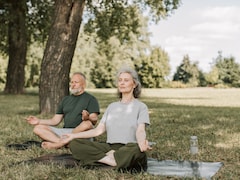To continue living healthily, even in old age it is important to exercise. Here are a few exercise options you can perform.

Fitness after 60: As we grow older our body starts to disintegrate but you can exercise
Changes in the body after you turn 60
A lot of changes occur as we turn older, not as much in the body but in the way we use our body. A major part of the day is spent sitting or lying down. This can cause problems associated with a sedentary lifestyle, like obesity and heart disease. Dementia and dependence on others are two common characteristics of old age that can be turned away with exercise. On a strictly physical level, once you turn 60, cell renewal in the epidermis slows down. Your hearing and eyesight deteriorates. Bone mass falls and wear & tear of muscles becomes common. This does not mean that you cannot achieve the fitness level of a 40-year old but only that you cannot do so with the same intensity and speed.
Safe Exercises To Do
Here are some fail-safe workouts to keep your body in good shape as you get to the end of the life-scale:
1. Aerobic exercises
After you turn 60, your muscle mass falls, slowing down your metabolism rate. So it becomes tough to lose a few extra kgs of weight. Aerobic exercises help to increase your heart rate and burn fat. This includes walking, swimming, biking and even dancing.
2. Stretching
With age, the flexibility of your joints decreases. This means that you cannot easily perform everyday chores with the same range of motion as you could previously. Simple stretching exercises like head and shoulder rolls, wrist and ankle circles and forward-backward bending will help you improve your flexibility.
3. Resistance building
This form of exercising helps to power up your immune system and prevent muscle loss.This includes light training. It is especially ideal for males. 30 minute weight workouts, once a week will help you gain your strength back. You need not do any major power lifting.
4. Bone-building
Osteoporosis is a common old-age problem caused due to the loss in bone mass. As we age, our bone density and mineral content decreases. In women, this problem is pronounced due to the fall in estrogen levels after menopause, leading to a slumped back. This also means that your body is more prone to fractures now. Exercises for bone-building include bicep curls and knee raises.
5. Full-Body Workouts
Exercising multiples times a week may not be practical when you are over 60. A better idea instead is to choose one exercise per muscle group to include in your workout regimen. For example, you can do tricep push down for your arm muscles, machine pull-downs for your back followed by bench presses for your chest.
What Not To Do
Before getting into action, remember that turning 60 also means slowing your pace down. There are some exercises that should stay strictly off your limits.
To avoid injuries, avoid leg and back extensions. Also keep away from jump training, sprinting and lifting heavy weights.
Do these exercises regularly to stay mentally and physically fit as you bid farewell to your younger years.
DoctorNDTV is the one stop site for all your health needs providing the most credible health information, health news and tips with expert advice on healthy living, diet plans, informative videos etc. You can get the most relevant and accurate info you need about health problems like diabetes, cancer, pregnancy, HIV and AIDS, weight loss and many other lifestyle diseases. We have a panel of over 350 experts who help us develop content by giving their valuable inputs and bringing to us the latest in the world of healthcare.














